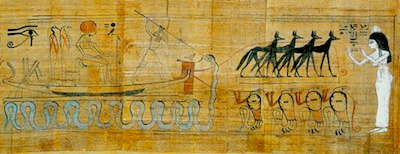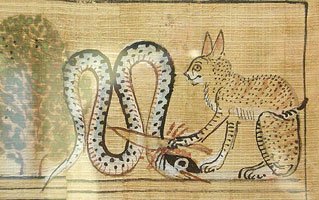Apep (Aapep, Apepi or Apophis) was the ancient Egyptian spirit of evil, darkness and destruction. As the arch enemy of the sun god, Ra, he was a malevolent force who could never be entirely vanquished. Every night, as the sun travelled though the underworld (or across the sky), his roar would fill the air and he would launch his attack.

Although he was believed to have existed since primeval times, Apep is not mentioned by name until the Middle Kingdom. It is possible that he was born out of the chaos and uncertainty brought about by the end of the Old Kingdom. However, some experts have questioned whether the First Intermediate period was actually a dark age, and it is also possible that depictions of large serpents on Predynastic pottery may relate to him.
There a number of serpent gods or demons who appear in early texts (such as the Pyramid Texts) as representatives of evil or chaos. However, the mythology surrounding him largely developed during the New Kingdom in funerary texts such as the Duat (or Amduat). During the Roman Period, he was sometimes referred to as “he who was spat out” and considered to have been born of the saliva of the goddess Neith.

According to one myth, Apep would hypnotise the sun god and all of his followers, except Set who would repel the serpent by piercing his side with a great spear. In some texts, Apep would trap the boat of Ra in his massive coils (referred to as sandbanks) or cause the waters of the underworld to flood to overwhelm him. In other texts Apep was equated with Set (who was after all a god of chaos) and an army of major and minor gods and goddesses (including Isis, Neith, Serqet (Selket), Geb, Aker and the followers of Horus and other unnamed gods in the form of monkeys) would defend him. The dead themselves (sometimes in the form of the god Shu) could also fight Apep to help maintain Ma´at (order). Apep would swallow the sun god, but they would cut a hole in the belly of the snake to allow the sun god to escape. If they failed, the world would be plunged into darkness.
Like Set, Apep was also associated with various frightening natural events such as unexplained darkness caused by solar eclipse, storms and earthquakes. They were both linked to the northern sky (a place that the Egyptians considered to be cold, dark and dangerous) and they were both at times associated with Taweret, the demon-goddess. However, unlike Set he was always a force for evil and could not be reasoned with.

Apep was often depicted as a huge serpent with tightly compressed coils to emphasis his huge size. In funerary texts he is usually shown in the process of being dismembered in various ways. In a detailed depiction in the tomb of Ramesses VI twelve heads are painted above the head of the snake representing the souls he has swallowed who are briefly freed when his body is destroyed, only to be imprisoned again the following night. In an alternative depiction inscribed in a number of tombs of private individuals Hathor or Ra is transformed into a cat who slices the huge serpent with a knife. Apep was also represented by a circular ball, the “evil eye” of Apep, being struck by the pharaoh in numerous temple scenes.

Apep was known by many epithets, such as “the evil lizard”, “the encircler of the world”, “the enemy” and “the serpent of rebirth”. He was not worshipped, he was feared, but was possibly the only god (other than The Aten during the Amarna period) who was considered to be all powerful. He did not require any nourishment and could never be completely destroyed, only temporarily defeated.
Apep led an army of demons that preyed on the living and the dead. To defeat this malevolent force a ritual known as “Banishing Apep” was conducted annually by the priests of Ra. An effigy of Apep was taken into the temple and imbued with all of the evil of the land. The effigy was then beaten, crushed smeared with mud and burned. Other rituals involved the creation of a wax model of the serpent which was ritually dismembered and the burning of a papyrus bearing an image of the snake. The “Book of Apophis” is a collection of magical spells from the New Kingdom which were supposed to repel or contain the evil of the serpent.
Apep was hated and feared by the Egyptians, but two of the Hyksos rulers took his name as their coronation name (although they used a slightly different spelling).
Bibliography
- Bard, Kathryn (2008) An introduction to the Archaeology of Ancient Egypt
- Pinch, Geraldine (2002) Handbook Egyptian Mythology
- Redford Donald B (2002) Ancient Gods Speak
- Watterson, Barbara (1996) Gods of Ancient Egypt
- Wilkinson, Richard H. (2003) The Complete Gods and Goddesses of Ancient Egypt
Copyright J Hill 2010